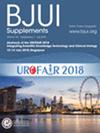输尿管镜治疗上尿路上皮癌后膀胱内复发:荟萃分析
IF 4.4
2区 医学
Q1 UROLOGY & NEPHROLOGY
引用次数: 0
摘要
目的评估输尿管镜(URS)联合激光消融对上尿路上皮癌(UTUC)患者的肿瘤预后,即膀胱内复发(IVR)率、根治性肾输尿管切除术(RNU)与治疗比和总生存率(OS)的作用,这是一个文献中研究不足的研究领域。材料和方法系统检索(PROSPERO: CRD42025642480)按照系统评价和Meta分析首选报告项目(PRISMA)声明进行。采用合并分析来量化IVR率、根治性肾输尿管切除术(RNU) -治疗比和OS的效应大小(ES)。进行亚组分析以评估接受术后灌注的患者,并将URS与激光消融与RNU进行比较。结果共纳入24项研究,涉及1904例患者。IVR总有效率为23.7% (n = 453)。总体汇总分析显示,IVR的ES为0.33,RNU - to - treatment ratio为0.23,OS为0.62(均P≤0.005)。在URS与RNU的比较中,IVR的URS合并ES为1.14,OS的URS合并ES为1.43 (P > 0.05)。在接受术后灌注的患者亚组分析中,IVR的合并ES为0.38 (P = 0.029), RNU - to - treatment ratio为0.25 (P = 0.012)。结论本系统综述发现,激光消融URS对IVR率的影响可以忽略不计。此外,当URS与RNU比较时,IVR和OS没有统计学意义上的差异。URS可以在不影响UTUC患者肿瘤预后的情况下进行。本文章由计算机程序翻译,如有差异,请以英文原文为准。
Intravesical recurrence after therapeutic ureteroscopy for upper tract urothelial carcinoma: a meta‐analysis
ObjectiveTo assess the role of ureteroscopy (URS) with laser ablation on oncological outcomes, namely, intravesical recurrence (IVR) rate, radical nephroureterectomy (RNU)‐to‐treat ratio and overall survival (OS), in patients with upper tract urothelial carcinoma (UTUC), an area of study that has been insufficiently addressed in the literature.Materials and MethodsA systematic search (PROSPERO: CRD42025642480) was performed according to the Preferred Reporting Items for Systematic Reviews and Meta‐analyses (PRISMA) statement. A pooled analysis was performed to quantify the effect size (ES) for IVR rate, radical nephroureterectomy (RNU)‐to‐treat ratio and OS. Subgroup analyses were performed to evaluate patients who received postoperative instillations and to compare URS with laser ablation to RNU.ResultsOverall, 24 studies involving 1904 patients were included in the final analysis. The overall rate of IVR was 23.7% (n = 453). The overall pooled analysis showed an ES for IVR of 0.33, for RNU‐to‐treat ratio of 0.23, and for OS of 0.62 (all P ≤ 0.005). In the comparison between URS and RNU, the pooled ES of URS for IVR was 1.14 and for OS it was 1.43 (all P > 0.05). Within the subgroup analysis of patients who received postoperative instillations, the pooled ES for IVR was 0.38 (P = 0.029) and for RNU‐to‐treat ratio it was 0.25 (P = 0.012).ConclusionsIn this systematic review, URS with laser ablation was found to exert a negligible effect on IVR rate. Moreover, no statistically significant differences in IVR nor in OS were recorded when URS was compared to RNU. URS can be performed without compromising the oncological outcomes of patients with UTUC.
求助全文
通过发布文献求助,成功后即可免费获取论文全文。
去求助
来源期刊

BJU International
医学-泌尿学与肾脏学
CiteScore
9.10
自引率
4.40%
发文量
262
审稿时长
1 months
期刊介绍:
BJUI is one of the most highly respected medical journals in the world, with a truly international range of published papers and appeal. Every issue gives invaluable practical information in the form of original articles, reviews, comments, surgical education articles, and translational science articles in the field of urology. BJUI employs topical sections, and is in full colour, making it easier to browse or search for something specific.
 求助内容:
求助内容: 应助结果提醒方式:
应助结果提醒方式:


